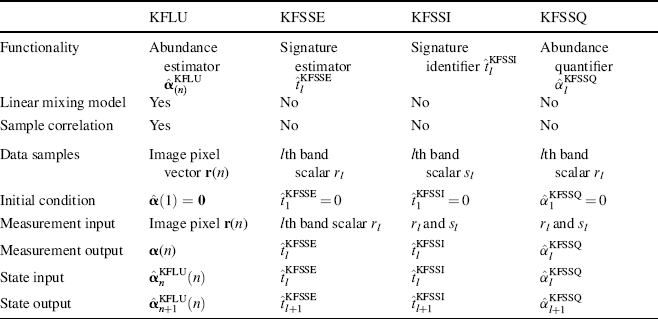28.7 Conclusions
Spectral characterization provides important and crucial features in target discrimination, detection, classification, identification, and quantification. This chapter presents new applications of Kalman filtering in spectral characterization and further develops three KFSCSP techniques, a spectral abundance estimator, called KFSSE, a spectral quantifier, called KFSSQ, and a spectral identification, called KFSSI. The proposed KFSSE, KFSSI, and KFSSQ are quite different from the Kalman filter-based linear spectral unmixing developed by Chang and Brumbley (1999a, 1999b) in the sense that while the former is designed for one-dimensional spectral data the latter is developed for unmixing image data. A comparison among KFLU, KFSSE, KFSSI, and KFSSQ is summarized in Table 28.28.
Table 28.28 Comparison among KFLU, KFSSE, KFSSI, and KFSSQ.

It is worth noting that depending upon applications, the measurement and state equations used to describe KFSSE, KFSSI, and KFSSQ are all different. For example, both KFSSE and KFSSI have the state noise v included in their state equations, while KFSSQ does not have one in its state equation. Moreover, KFSSE uses the same target signature vector t in both measurement equation and state equation compared with KFSSI, which uses a matching signature vector s in its measurement equation and the target signature vector t in its state equation. ...
Get Hyperspectral Data Processing: Algorithm Design and Analysis now with the O’Reilly learning platform.
O’Reilly members experience books, live events, courses curated by job role, and more from O’Reilly and nearly 200 top publishers.

